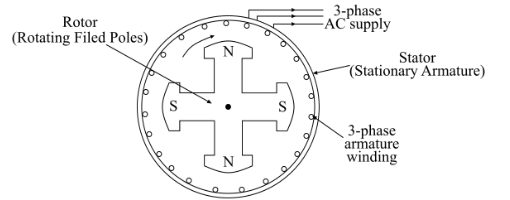A stationary armature-rotating field alternator has several advantages over a rotating armature-type alternator, as given below-
When a stationary armature is used in the alternator, the output current can be taken directly from the fixed terminals on the stationary armature without using slip rings, brushes, etc.
- The armature windings of the rotating field alternator, being stationary, are not subjected to vibration and centrifugal forces.
- A stationary armature can be easily insulated for the high voltage for which the alternator is designed. This generated voltage may be as high as 33 kV.
- When the stationary armature is used, the armature windings can be braced better mechanically against the high electromagnetic forces due to large short circuit currents.
- The rotating field is supplied with the direct current. Thus, only two slip rings are required to provide direct current for the rotating field. Generally, the field voltage is between 100 to 500 volts and hence the insulation of the low-voltage slip rings from the shaft can be provided easily.
- The weight of the armature windings is greater than the windings of the rotating field poles. Therefore, the rotating field type alternator has a smaller size than a rotating armature type alternator.
- a stationary armature may be cooled easily because the size of the armature can be increased to provide more cooling ducts.
- Since the rotating field is comparatively light, it can be constructed for high-speed rotation.
- The forced cooling with gas or liquids can be easily provided in stationary armature-type alternators.
- The cost of the rotating field type alternator is low as compared to the rotating armature type alternator.
Stationary Armature vs. Rotating Armature in Synchronous Machines
Q1. Why is a rotating field preferred over a rotating armature in synchronous machines?
A rotating field is preferred because it allows the armature (which carries the output power) to remain stationary. This simplifies insulation, allows for easier cooling, avoids the use of brushes and slip rings for high currents, and improves mechanical strength under short circuit conditions.
Q2. What are the main advantages of a stationary armature in an alternator?
Key advantages include:
- Elimination of slip rings and brushes for power output.
- Better insulation for high-voltage output.
- Improved cooling and mechanical support.
- Reduced vibration and centrifugal forces on windings.
- More cost-effective construction.
Q3. How does a stationary armature improve insulation in alternators?
Since the armature does not rotate, high-voltage windings can be more effectively insulated. This is especially useful in large alternators where voltages can reach up to 33 kV or more.
Q4. Why is maintenance easier in stationary armature alternators?
The stationary armature design eliminates moving contacts for power output, reducing wear and maintenance issues associated with brushes and slip rings.
Q5. What type of cooling is possible in a stationary armature alternator?
Stationary armatures allow for better and more efficient cooling. Forced air, hydrogen, or even liquid cooling methods can be implemented easily due to more accessible and larger design space.
Q6. Why are rotating field alternators more compact in size?
In rotating field machines, only the lightweight field system rotates. Since the heavier armature remains stationary, the machine's size and structural requirements are reduced, making the alternator more compact and efficient.
Q7. What voltage range is typically supplied to the rotating field?
The rotating field is supplied with DC voltage, usually ranging between 100V to 500V, which requires only two slip rings with low insulation requirements.

